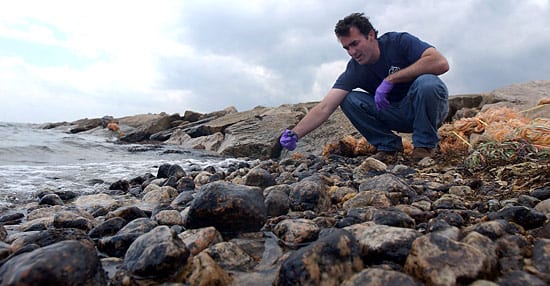Christopher Reddy, Marine Chemist
Oil spills are terrible for the environment, but they also provide an excellent opportunity to study how the ocean and its ecosystems respond to extreme events. Most people see a spill and focus only on its toxic effects. But marine chemist Chris Reddy and colleagues see it as a huge injection of carbon-based food for microbes in the coastal environment. They ask questions like: How long does it take the oil to decay and get consumed by microbes? How long will oil persist at a particular location and why? Do people need to intervene and assist in cleanups, or can Mother Nature remediate the ecosystem?
Reddy grew up on Rhode Island’s Narragansett Bay and has always lived within a few miles of a coast. After earning bachelor’s and doctoral degrees in chemistry and chemical oceanography, Reddy came to the Woods Hole Oceanographic Institution and became an heir to one of the longest-running studies of an oil spill in U.S. scientific history. Following in the footsteps of two generations of chemists and ecologists, Reddy began looking for clues to the lingering effects of an oil spill that hit the coast of Cape Cod in 1969.
Working in marshes that appear to have long since recovered from the spill of 189,000 gallons of fuel oil, Reddy and associates found potent traces of oil just a few inches belong the sandy surface. Equipped with state-of-the-art chemistry equipment—including comprehensive two-dimensional gas chromatography—and plenty of old-fashioned elbow grease, the research team has documented not only the chemical residues of the accident—which have not changed much in three decades—but also the biological effect. In 2007, they showed that fiddler crabs and marsh grasses are still suffering from lingering oil.
Reddy also has had a spill of his own to document. In 2003, just months after Reddy published a landmark paper on the 1969 spill, 98,000 gallons of No. 6 fuel oil spilled into Massachusetts’ Buzzards Bay, and the WHOI chemistry team was there to capture samples of the oil as it slicked the waters and coated the beaches. This time, nature seemed to disperse and decay the oil in ways that may not be so persistently harmful. But there was plenty to learn from the processes of washing the oil away.
With fellow chemist Dave Valentine of UC Santa Barbara, Reddy is now studying natural oil seeps off the coast of California. Every day, the seafloor naturally spews tons of oil into the Pacific, and yet the environment has adapted ways to accommodate the bubbling crude. Reddy would love to know: what are the microbes doing to it? how does this oil naturally decay? what does it mean for manmade spills?
And Reddy is also turning his attention the next fuel of choice: biodiesel. Presented as the great solution to our global addiction to petroleum, biodiesel may or may not be harmful to the environment. In the Reddy laboratory, they are trying to anticipate and analyze how these new fuels might react when this new oil inevitably mixes with water.

See Also
'Drunk' Fiddler Crabs
An Oceanus magazine story
Oil in Our Coastal Back Yard
An Oceanus magazine story
